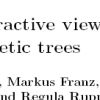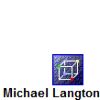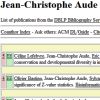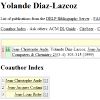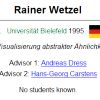| |
 
Philippe Gambette and
Daniel H. Huson. Improved Layout of Phylogenetic Networks. In TCBB, Vol. 5(3):472-479, 2008.
Keywords: abstract network, heuristic, phylogenetic network, phylogeny, Program SplitsTree, software, split network, visualization.
Note: http://hal-lirmm.ccsd.cnrs.fr/lirmm-00309694/en/.
Toggle abstract
"Split networks are increasingly being used in phylogenetic analysis. Usually, a simple equal-angle algorithm is used to draw such networks, producing layouts that leave much room for improvement. Addressing the problem of producing better layouts of split networks, this paper presents an algorithm for maximizing the area covered by the network, describes an extension of the equal-daylight algorithm to networks, looks into using a spring embedder, and discusses how to construct rooted split networks. © 2008 IEEE."
|
|
| |
 
Tobias Kloepper and
Daniel H. Huson. Drawing explicit phylogenetic networks and their integration into SplitsTree. In BMCEB, Vol. 8(22), 2008.
Keywords: explicit network, phylogenetic network, phylogeny, Program SplitsTree, software, split network, visualization.
Note: http://dx.doi.org/10.1186/1471-2148-8-22.
Toggle abstract
"Background. SplitsTree provides a framework for the calculation of phylogenetic trees and networks. It contains a wide variety of methods for the import/export, calculation and visualization of phylogenetic information. The software is developed in Java and implements a command line tool as well as a graphical user interface. Results. In this article, we present solutions to two important problems in the field of phylogenetic networks. The first problem is the visualization of explicit phylogenetic networks. To solve this, we present a modified version of the equal angle algorithm that naturally integrates reticulations into the layout process and thus leads to an appealing visualization of these networks. The second problem is the availability of explicit phylogenetic network methods for the general user. To advance the usage of explicit phylogenetic networks by biologists further, we present an extension to the SplitsTree framework that integrates these networks. By addressing these two problems, SplitsTree is among the first programs that incorporates implicit and explicit network methods together with standard phylogenetic tree methods in a graphical user interface environment. Conclusion. In this article, we presented an extension of SplitsTree 4 that incorporates explicit phylogenetic networks. The extension provides a set of core classes to handle explicit phylogenetic networks and a visualization of these networks. © 2008 Kloepper and Huson; licensee BioMed Central Ltd."
|
|
| |

Tobias Kloepper. Algorithms for the Calculation and Visualisation of Phylogenetic Networks. PhD thesis, Eberhard-Karls-Universität Tübingen, Germany, 2008.
Keywords: from rooted trees, from sequences, from unrooted trees, galled network, phylogenetic network, phylogeny, Program SplitsTree, reconstruction, split network, visualization.
Note: https://publikationen.uni-tuebingen.de/xmlui/handle/10900/49159.
|
|
| |
  
Gabriel Cardona,
Francesc Rosselló and
Gabriel Valiente. Extended Newick: It is Time for a Standard Representation. In BMCB, Vol. 9:532, 2008.
Keywords: evaluation, explicit network, phylogenetic network, Program Bio PhyloNetwork, Program Dendroscope, Program NetGen, Program PhyloNet, Program SplitsTree, Program TCS, visualization.
Note: http://bioinfo.uib.es/media/uploaded/bmc-2008-enewick-sub.pdf.
|
|
|
 - forked on GitHub.
- forked on GitHub.






























